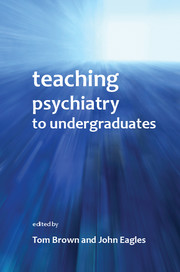Book contents
- Frontmatter
- Contents
- List of figures, tables and boxes
- List of contributors
- Preface
- Foreword
- 1 How do students learn?
- 2 Recent developments in undergraduate medical education
- 3 Undergraduate psychiatry teaching – the core curriculum
- 4 The organisation of undergraduate teaching
- 5 Assessment of undergraduates in psychiatry
- 6 Using computers to teach undergraduate psychiatry
- 7 How to give a lecture
- 8 How to do small-group teaching
- 9 Problem-based learning
- 10 Teaching trainee psychiatrists how to teach medical students: the Southampton model
- 11 Involving trainees in teaching
- 12 Involvement of service users in psychiatric education
- 13 Time-efficient clinical teaching
- 14 Intercalated degrees
- 15 Undergraduate experiences of psychiatry: a student view
- 16 Integration: teaching psychiatry with other specialties
- 17 Teaching the teachers in a cross-cultural setting: the Scotland–Malawi Mental Health Education Project
- 18 International undergraduate teaching
- 19 Teaching with simulated patients and role-play
- 20 Undergraduate medical education and recruitment to psychiatry
- 21 Choosing psychiatry: factors influencing career choice among foundation doctors in Scotland
- 22 Funding of the teaching of medical undergraduates
- 23 Dealing with students in difficulty
- 24 Training medical students to promote good mental health in secondary schools
- 25 Women in medicine
- Index
12 - Involvement of service users in psychiatric education
Published online by Cambridge University Press: 02 January 2018
- Frontmatter
- Contents
- List of figures, tables and boxes
- List of contributors
- Preface
- Foreword
- 1 How do students learn?
- 2 Recent developments in undergraduate medical education
- 3 Undergraduate psychiatry teaching – the core curriculum
- 4 The organisation of undergraduate teaching
- 5 Assessment of undergraduates in psychiatry
- 6 Using computers to teach undergraduate psychiatry
- 7 How to give a lecture
- 8 How to do small-group teaching
- 9 Problem-based learning
- 10 Teaching trainee psychiatrists how to teach medical students: the Southampton model
- 11 Involving trainees in teaching
- 12 Involvement of service users in psychiatric education
- 13 Time-efficient clinical teaching
- 14 Intercalated degrees
- 15 Undergraduate experiences of psychiatry: a student view
- 16 Integration: teaching psychiatry with other specialties
- 17 Teaching the teachers in a cross-cultural setting: the Scotland–Malawi Mental Health Education Project
- 18 International undergraduate teaching
- 19 Teaching with simulated patients and role-play
- 20 Undergraduate medical education and recruitment to psychiatry
- 21 Choosing psychiatry: factors influencing career choice among foundation doctors in Scotland
- 22 Funding of the teaching of medical undergraduates
- 23 Dealing with students in difficulty
- 24 Training medical students to promote good mental health in secondary schools
- 25 Women in medicine
- Index
Summary
Introduction
The literature on the involvement of service users or patients in medical education almost suggests that this is something that has happened only over the past decade or so. Anyone involved in clinical medical education will be aware that service users have always been a central component of teaching – you cannot teach clinical medicine without them. However, over the past couple of decades the roles played by service users have changed and diversified and service users have become more active partners. As an example, many service users/survivors and carers have emphasised the need for training in ‘emotional care’ and the need for clinical competence to be coupled with humanity. Within this model, human relationships are deemed to be at the core of mental health and practitioners demonstrating a shared humanness (Carson et al, 2008) with their clients increase the likelihood of successful outcomes.
In this chapter we begin with a brief discussion of terminology and the political drivers that have influenced the process. Where possible, we have referred to the literature as it relates to the teaching of psychiatry; otherwise we have used evidence from other medical disciplines. We consider the different levels of service user involvement in medical education. There is then a review of different stakeholder perspectives with respect to service user involvement – the key stakeholders being service users, medical students and teachers. There is then a discussion of the nature of service user involvement. Finally, the challenges are considered. We do not address the advantages and disadvantages of using real versus simulated patients, since Chapter 19 focuses on this. As the literature relating to service user involvement in medical education has grown, this chapter focuses on that literature but acknowledges that other disciplines, such as nursing, have developed practice in these areas (e.g. Langton et al, 2003; Felton & Stickley, 2004).
Terminology
The Royal College of Psychiatrists has argued that the preferred use by those to whom the term refers is ‘service users and carers’. However, although we shall use this term as it is now widely used in psychiatry and mental health, we note that this does not necessarily reflect the views of the majority (Swift et al, 2000; McGuire-Snieckus et al, 2003).
- Type
- Chapter
- Information
- Teaching Psychiatry to Undergraduates , pp. 141 - 151Publisher: Royal College of PsychiatristsPrint publication year: 2011

